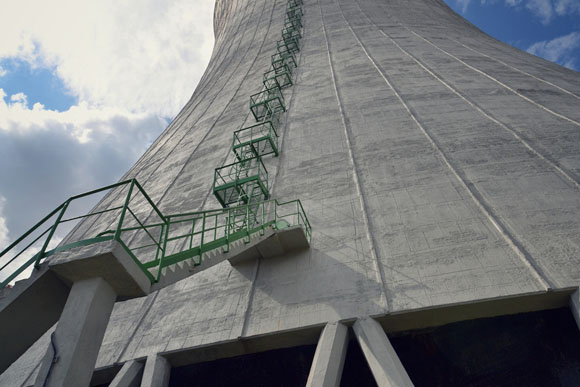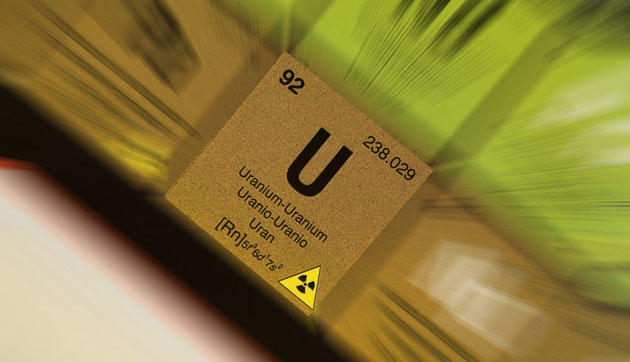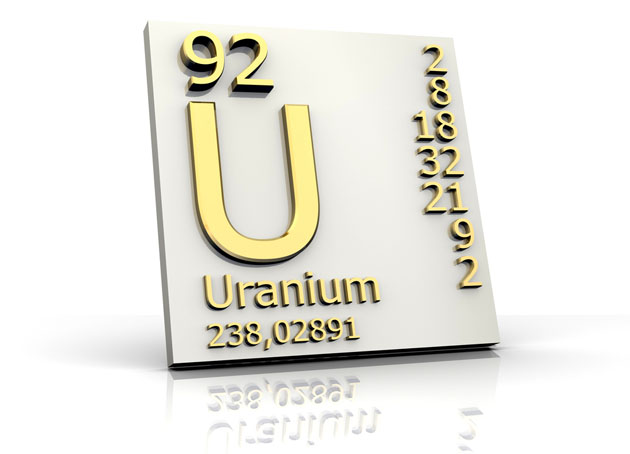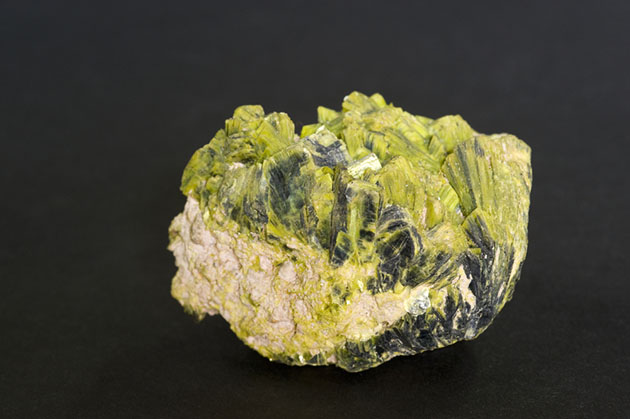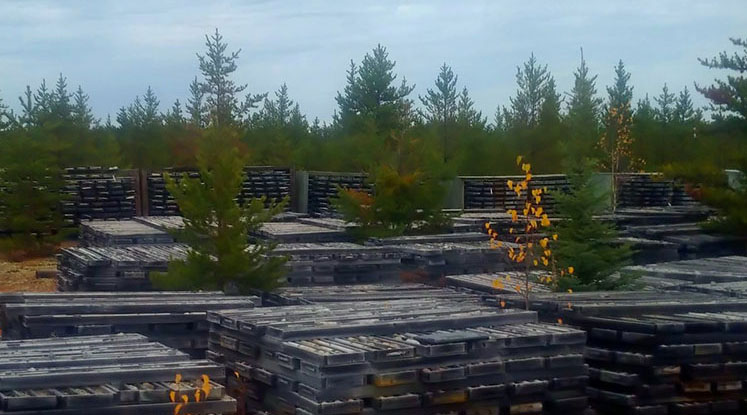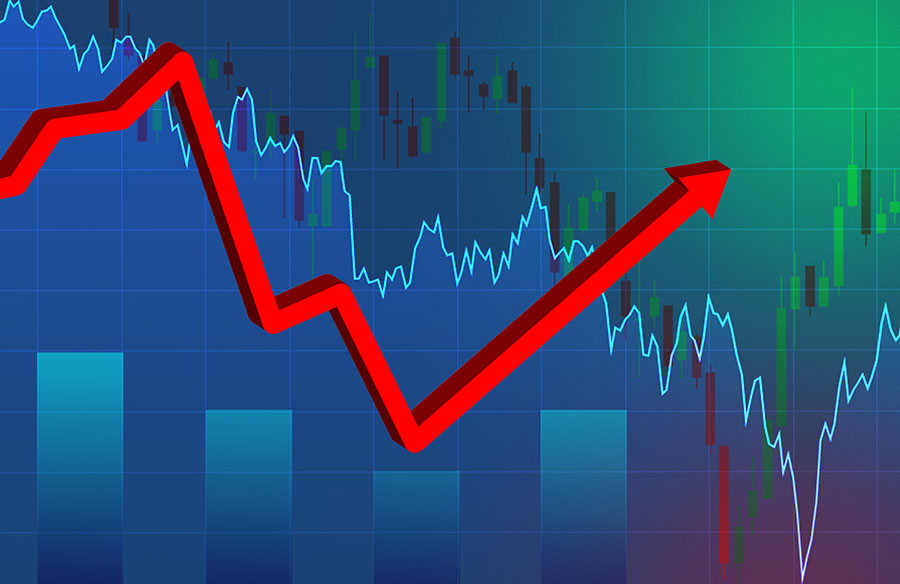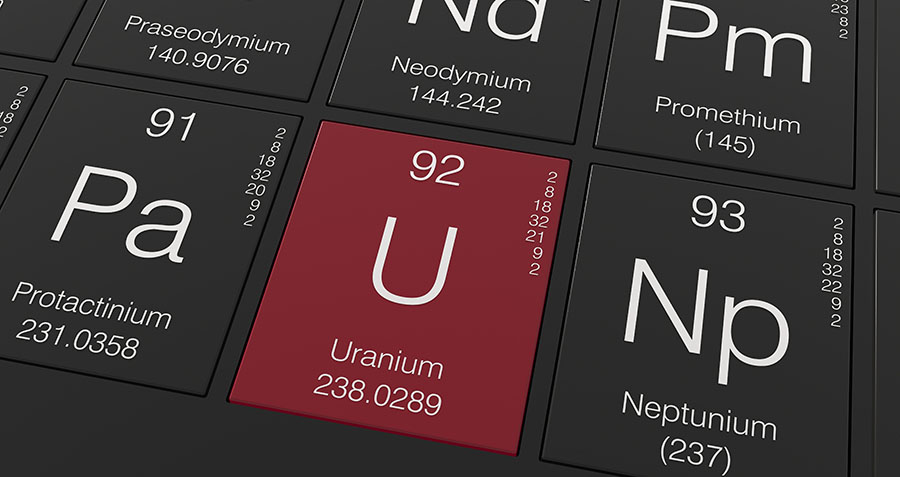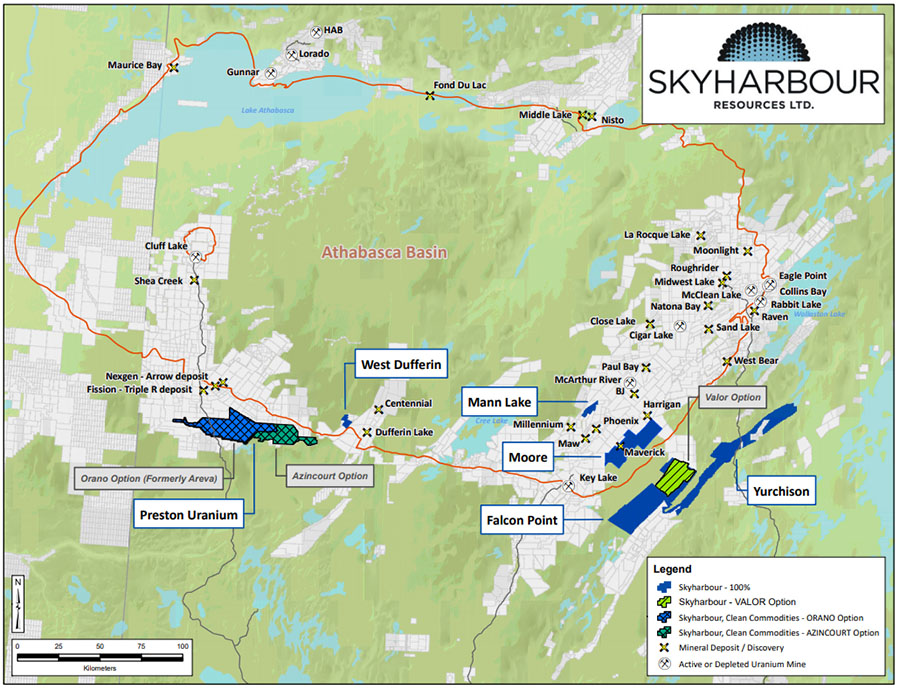TICKERS: AREVA, CCO; CCJ, , DML; DNN, EFR; UUUU, FIS, , , MGA, TVC; TGP, UWE; UWEFF
Rob Chang: Nuclear Power Growth Is Inevitable
Interview
Source: George Mack of The Energy Report (3/1/11)
 Long-term demand growth for uranium is a global story, with China expected to far exceed any other single nation in new nuclear plant construction over the next decade. Versant Partners Analyst Rob Chang looks for equity ideas that investors can play to leverage these growing requirements for uranium fuel. In this exclusive interview with The Energy Report, Rob highlights some interesting companies.
Long-term demand growth for uranium is a global story, with China expected to far exceed any other single nation in new nuclear plant construction over the next decade. Versant Partners Analyst Rob Chang looks for equity ideas that investors can play to leverage these growing requirements for uranium fuel. In this exclusive interview with The Energy Report, Rob highlights some interesting companies.
The Energy Report: What is your uranium forecast for the intermediate term and for the long term?
Rob Chang: For 2011, currently we have the spot price at $75/lb. Then the following two years we expect it to go up to $80/lb. and then take a slight step down in 2014 to $75/lb. For 2015 we have it at $72.50/lb. And then long term, we're currently expecting $70/lb.
TER: Why does the price forecast go down?
RC: Just to be conservative. Over the long term, as any economist would tell you, prices should revert to a point where the marginal costs equal marginal revenue. Basically the company that incrementally produces enough to satisfy market demand should be pretty much breaking even. Despite the fact we have a short-term increase, over the long term we do expect that market forces will work.
TER: I don't know if round numbers have any technical significance, but between the end of October and now, uranium has broken through the $50/lb., $60/lb. and $70/lb. levels. Does the fact that it didn't test those levels for long imply demand?
RC: Absolutely. I was personally of the belief that the prices were way too low for where they should be. The only reason why it stayed at such depressed levels was that investors were just afraid to get into the market during the economic weakness. Then when things started to turn around people paid attention, realized and then committed their capital into uranium, and once it started moving up it quickly adjusted to more reasonable levels. So, technical analysis doesn't always work and I think this is a situation where you can clearly see that these round numbers didn't really mean anything as the price advanced to where it should be.
TER: Where is the demand going to come from?
RC: Like everything else in the world, the strongest demand is coming from China. Currently there are around 443 nuclear reactors in the world, and China has only 13, which accounts for 3%. China is now the second largest economy in the world, recently surpassing Japan, and given how strong the Chinese economy is and is expected to be, just 3% of the global nuclear power production is a little ridiculous considering its energy needs and the fact that nuclear provides the best base load power supply. And you can see this easily in the number of planned and proposed nuclear reactors for construction.
According to the World Nuclear Association (WNA), of the 540 nuclear plants that are currently in the construction, planned or proposed phase around the world, China accounts for 35% of them. About 187 of the 540 are in China in some stage of development. China's doing three times the number of Russia, and I think that's pretty significant.
TER: Can demand fluctuate?
RC: Of all commodities, uranium is one of the best in terms of forecasting demand because you can't miraculously create another nuclear power plant. There are a lot of years, planning, permitting and capital required. It's fairly certain that once one is being built, it's going to go to completion and that demand will be there.
TER: Tell me about your initial screen, the enterprise value per pound (EV/lb.) of uranium in the ground. Describe that for me briefly.
RC: Sure. The EV/lb. metric that I use essentially common-sizes the universe of uranium companies by applying the EV/lb. metric for every company. I prefer enterprise value over market cap because it includes the debt and the cash numbers, which I believe are fairly significant in the decision of investing in any company. It also allows for easier comparison. You're going to have different companies with different resource sizes, and you can see whether one may be overvalued or undervalued on a per-pound basis.
TER: I understand that valuations can vary from exploration company all the way up the value chain to producer, but under what EV/lb. level would you consider looking at a company as a long position?
RC: I wouldn't say there's an exact hard rule in terms of what number I would look at, given that EV/lb. is basically a screening tool or even just a sorting tool in terms of showing where companies fit in the grand scheme of things. The key thing to note is that some companies do deserve to be where they sit. A good example is Hathor Exploration Ltd. (TSX.V:HAT), which has one of the highest EV/lb. valuations. It should not be trading below the average given the location and grade of the project. So, it would be rather unfair to cut it off at an arbitrary number just because it seems to be above that number.
TER: Where do you go next?
RC: I then get in contact with management and try and meet with them. I want to understand management and find out where they came from and ask them what they're doing with their project now as well as understand what their plans are.
How they see their project is important to me, because I want to weed out the promoters versus the actual developers or exploration people. It's key to find companies that have good projects and the personnel to advance the project. I've run into some situations where companies may have a decent project, but they don't seem to have the management team to actually push them forward. That's the key thing, because any good project can be ruined by bad management.
So, that would be the first cut. After that it would be to understand the political environment and effectively performing good fundamental analysis such as understanding the grade of the deposits. Metallurgy is also extremely important.
TER: Tell me about that process of evaluating management.
RC: Pedigrees do matter. It is not essential, but knowing that someone came from a well-run firm helps. For example, someone who has come from a Cameco Corp. (TSX:CCO; NYSE:CCJ) or an AREVA (PAR:CEI), where they know the process and how to do things in a high quality way rather than a "let's just cover this pot with this lid" approach.
TER: Does having excellent leadership at the C-level translate to great engineers and people on the ground?
RC: I find it generally does. You attract better talent when you have a leader that has a history of success and strong management skills.
TER: Do you have a stock that you have initiated coverage on or had coverage transferred that you like?
RC: Sure, I just had the coverage of Energy Fuels, Inc. (TSX:EFR) transferred over to me. I really like the story. It's a near-term producer that's currently in development mode as it has recently received a permit from the Colorado Department of Public Health and Environment. It's probably the most difficult to acquire permit, and it will allow them to process 500 tons per day (tpd) of uranium ore.
The great and interesting point about the story is that the company currently has two turnkey mines already in its portfolio, those being the Energy Queen and the Whirlwind mines, which can both be brought up to speed and producing within a year, if not less, of the decision to do so—probably less actually. So, EFR can be producing soon and can capitalize on the high uranium spot prices right off the bat and join the producer category in very short order. That's something that a lot of other uranium companies cannot do given the extensive permitting, development and funding process required. So, it is well up the curve and extremely close to production relative to almost any other non-producer. It looks great.
TER: So much of the news about its near-term production has been discounted into the price over the past six months during which time the price has nearly quadrupled. You still have a target price of $2 for an implied 40%-plus total return from here. Could you give me a little background on that valuation?
RC: I think the quadrupling was more a matter of the stock price being previously depressed for Energy Fuels. Speaking as a former portfolio manager, I would have adopted a "prove you can get a permit" perspective because there was some doubt that EFR was going to be able to get that permit.
Once that permit was granted, that overhang was removed and the stock quickly moved up to more reasonable levels. So, I believe that's the primary reason of the meteoric rise that you were noting. I still believe there's upside from here. Given expected production, I fully expect the mill to be expanded from 500 tpd to 1,000 tpd in short order. It is already designed with that in mind. So, once that gets put into place with additional consolidation, I think that the target price of $2 and possibly even higher is quite achievable.
TER: Rob, your target price on Energy Fuels is equivalent to the net asset value of the company. That sounds very conservative to me.
RC: This stock valuation is more from my buy side perspective, and I tend to be a lot more conservative. I don't like to be one of those guys who starts applying multiples without having the company prove that it is capable. Although the company looks strong and I have no reason to doubt management's abilities, they still have to prove that they can develop on time and on budget. So, even though it does have its permits in place, I'd rather be more conservative on our target price, which is still a substantial increase from its current trading value.
TER: One more question on Energy Fuels, I wanted to ask about the significance of the mill. The company calls it the first conventional uranium mill to be built in the U.S. in three decades. How does it add value to this play?
RC: It legitimizes the play. Any conventional uranium explorer with designs on becoming a uranium producer needs to have a mill to process its ore. Denison Mines Corp. (TSX:DML; NYSE.A:DNN) has one in the area, and now Energy Fuels will have one. So, in terms of being a strategic asset it's a very important piece—being able to consolidate the area, to become a producer and to eventually become a major player. Without the mill you need to have someone else's mill to process your ore. It's a major piece that's required to become a producer.
TER: What other companies can you talk about?
RC: I can make a few comments regarding Continental Precious Minerals Inc. (TSX:CZQ) and Hathor. CZQ has uranium plus moly (molybdenum ) and other metals in Alum Shale in Sweden at the Viken Project. The company has a billion pounds of uranium there. It's very low grade, and it's in a very tricky environment. Alum Shale hasn't really had much history of being processed. It was processed before by the Swedish Government but at very low recoveries and at pretty high costs. It's possibly one of the largest uranium deposits in the world—from what I could tell it's probably one of the top two or three. But the key question mark is whether it can be extracted economically. I know CEO Ed Godin is currently working the metallurgy, and I think that's really the key point—whether it can be economically produced at a commercial scale from the low-grade Alum Shale at a low enough cost in order for it to work. But overall it looks interesting.
TER: You mentioned Hathor.
RC: Hathor is a very strong story. From an EV/lb. perspective, it's trading at around $13/lb., which has it at the top valuation among exploration companies. This is one of the situations where it definitely deserves to be on the higher side of the EV/lb. average. Hathor is in the prolific Athabasca Basin, and it has some of the highest grades of any uranium property in the world. It already has around 25 million pounds (Mlb.) of attributable NI 43-101-compliant resources, and it has the potential for it to be even higher. So, Hathor does look very interesting.
TER: It deserves to be that high relative to everyone else?
RC: That's the key question. I do believe that at least a portion of the $13/lb. valuation is attributed to an expected resource increase. So, it really just depends on what number you want to hang on the increase to see if it trades closer to what its peers are. As a comparison, the average exploration company trades at a $3.17 EV/lb. So, Hathor definitely is a premium company, and it could be potentially much higher. It's very high grade. On a blended basis it has a U3O8 grade of 5.4%, which is extremely high given that the global median for uranium grades is 0.076% from my database. So, it's a fantastic grade.
TER: Not nearly as speculative as CZQ?
RC: Comparing the two, it's not even remotely close because Hathor is in a prolific area. The metallurgy is somewhat known given that there are many uranium mines in the area.
TER: Any others you might mention?
RC: There are some that are actually quite interesting. Hathor's neighbor Fission Energy Corp. (TSX.V:FIS) is interesting in that it also has encountered very high grades from its drill intercepts. It doesn't have a resource as of yet, but it is a stone's throw away from the Roughrider deposit. There are some pictures of their property where you can see Hathor's drills and Fission's drills right beside each other. You really could throw a stone from one and hit the other, and there seems like there is a reasonable chance that the mineralization could cross the boundary line.
TER: Ok, I'd love to hear another one.
RC: Kivalliq Energy Corp. (TSX.V:KIV) looks quite good. I tend to gravitate towards higher grade stories, and this one is interesting in that its NI 43-101 resource is at 0.79% U3O8, which is a pretty high grade deposit, one of the highest ones around actually. It's Angilak Project is located in Nunavut, Canada. The company appears to have strong relationships with the Nunavut people there. It currently has a resource of 14.2 Mlb. at one of the highest grades in the world, and it looks like it could be easily expandable. So, that's another one I'm keeping my eye on as well.
Tournigan Energy Ltd. (TSX.V:TVC, FSE:TGP) is a Slovakia uranium play. It's in the prefeasibility category right now, and it currently has 58 Mlb. in total resources. It's primary project is Kuriskova, and the key thing I like about it is that it's a high grade deposit at 0.413% U3O8. On a blended grade basis for all of its nearby properties, the company has a portfolio grade of 0.297% U3O8, which is quite good.
TER: Did you have another you wanted to mention?
RC: We can also talk about U3O8 Corp. (TSX.V:UWE). It has a few properties that it received from a transaction with Mega Uranium Ltd. (TSX:MGA), which effectively placed the latter's South American assets into U308 Corp. U308 is interesting in that it has three properties, one in Colombia, one in Guyana, which I have visited, and a third in Argentina. The Colombian property is interesting. It has pretty good grades, the potential for valuable byproducts such as phosphate and vanadium and has a lot of blue sky potential, and the Argentinean one looks like it could be a simple low-cost project that would require little capex to develop.
TER: Thank you and best wishes, Rob.
RC: Thank you.
Versant Partners Analyst Rob Chang has extensive financial markets experience dating back to 1995. He was a member of a five-person team running a multi-strategy hedge fund, a base metals research associate at BMO Capital Markets, a manager of resource funds at a boutique investment management company and an equity analyst covering the global mining sector at an independent investment bank. Rob has a Master of Business Administration degree from the Rotman School of Management at the University of Toronto and holds a Canadian Investment Manager designation.
Learn more about companies in the uranium sector now. . .
Want to read more exclusive Energy Report interviews like this? Sign up for our free e-newsletter, and you'll learn when new articles have been published. To see a list of recent interviews with industry analysts and commentators, visit our Expert Insights page.
DISCLOSURE:
1) George Mack of The Energy Report conducted this interview on Feb. 14th, 2011. He personally and/or his family own shares of the following companies mentioned in this interview: None.
2) The following companies mentioned in the interview are sponsors of The Energy Report: Mega Uranium, Fission Energy, Energy Fuels.
3) Rob Chang: I personally and/or my family own shares of the following companies mentioned in this interview: None. I personally and/or my family am paid by the following companies mentioned in this interview: None.
Rob Chang: For 2011, currently we have the spot price at $75/lb. Then the following two years we expect it to go up to $80/lb. and then take a slight step down in 2014 to $75/lb. For 2015 we have it at $72.50/lb. And then long term, we're currently expecting $70/lb.
TER: Why does the price forecast go down?
RC: Just to be conservative. Over the long term, as any economist would tell you, prices should revert to a point where the marginal costs equal marginal revenue. Basically the company that incrementally produces enough to satisfy market demand should be pretty much breaking even. Despite the fact we have a short-term increase, over the long term we do expect that market forces will work.
TER: I don't know if round numbers have any technical significance, but between the end of October and now, uranium has broken through the $50/lb., $60/lb. and $70/lb. levels. Does the fact that it didn't test those levels for long imply demand?
RC: Absolutely. I was personally of the belief that the prices were way too low for where they should be. The only reason why it stayed at such depressed levels was that investors were just afraid to get into the market during the economic weakness. Then when things started to turn around people paid attention, realized and then committed their capital into uranium, and once it started moving up it quickly adjusted to more reasonable levels. So, technical analysis doesn't always work and I think this is a situation where you can clearly see that these round numbers didn't really mean anything as the price advanced to where it should be.
TER: Where is the demand going to come from?
RC: Like everything else in the world, the strongest demand is coming from China. Currently there are around 443 nuclear reactors in the world, and China has only 13, which accounts for 3%. China is now the second largest economy in the world, recently surpassing Japan, and given how strong the Chinese economy is and is expected to be, just 3% of the global nuclear power production is a little ridiculous considering its energy needs and the fact that nuclear provides the best base load power supply. And you can see this easily in the number of planned and proposed nuclear reactors for construction.
According to the World Nuclear Association (WNA), of the 540 nuclear plants that are currently in the construction, planned or proposed phase around the world, China accounts for 35% of them. About 187 of the 540 are in China in some stage of development. China's doing three times the number of Russia, and I think that's pretty significant.
TER: Can demand fluctuate?
RC: Of all commodities, uranium is one of the best in terms of forecasting demand because you can't miraculously create another nuclear power plant. There are a lot of years, planning, permitting and capital required. It's fairly certain that once one is being built, it's going to go to completion and that demand will be there.
TER: Tell me about your initial screen, the enterprise value per pound (EV/lb.) of uranium in the ground. Describe that for me briefly.
RC: Sure. The EV/lb. metric that I use essentially common-sizes the universe of uranium companies by applying the EV/lb. metric for every company. I prefer enterprise value over market cap because it includes the debt and the cash numbers, which I believe are fairly significant in the decision of investing in any company. It also allows for easier comparison. You're going to have different companies with different resource sizes, and you can see whether one may be overvalued or undervalued on a per-pound basis.
TER: I understand that valuations can vary from exploration company all the way up the value chain to producer, but under what EV/lb. level would you consider looking at a company as a long position?
RC: I wouldn't say there's an exact hard rule in terms of what number I would look at, given that EV/lb. is basically a screening tool or even just a sorting tool in terms of showing where companies fit in the grand scheme of things. The key thing to note is that some companies do deserve to be where they sit. A good example is Hathor Exploration Ltd. (TSX.V:HAT), which has one of the highest EV/lb. valuations. It should not be trading below the average given the location and grade of the project. So, it would be rather unfair to cut it off at an arbitrary number just because it seems to be above that number.
TER: Where do you go next?
RC: I then get in contact with management and try and meet with them. I want to understand management and find out where they came from and ask them what they're doing with their project now as well as understand what their plans are.
How they see their project is important to me, because I want to weed out the promoters versus the actual developers or exploration people. It's key to find companies that have good projects and the personnel to advance the project. I've run into some situations where companies may have a decent project, but they don't seem to have the management team to actually push them forward. That's the key thing, because any good project can be ruined by bad management.
So, that would be the first cut. After that it would be to understand the political environment and effectively performing good fundamental analysis such as understanding the grade of the deposits. Metallurgy is also extremely important.
TER: Tell me about that process of evaluating management.
RC: Pedigrees do matter. It is not essential, but knowing that someone came from a well-run firm helps. For example, someone who has come from a Cameco Corp. (TSX:CCO; NYSE:CCJ) or an AREVA (PAR:CEI), where they know the process and how to do things in a high quality way rather than a "let's just cover this pot with this lid" approach.
TER: Does having excellent leadership at the C-level translate to great engineers and people on the ground?
RC: I find it generally does. You attract better talent when you have a leader that has a history of success and strong management skills.
TER: Do you have a stock that you have initiated coverage on or had coverage transferred that you like?
RC: Sure, I just had the coverage of Energy Fuels, Inc. (TSX:EFR) transferred over to me. I really like the story. It's a near-term producer that's currently in development mode as it has recently received a permit from the Colorado Department of Public Health and Environment. It's probably the most difficult to acquire permit, and it will allow them to process 500 tons per day (tpd) of uranium ore.
The great and interesting point about the story is that the company currently has two turnkey mines already in its portfolio, those being the Energy Queen and the Whirlwind mines, which can both be brought up to speed and producing within a year, if not less, of the decision to do so—probably less actually. So, EFR can be producing soon and can capitalize on the high uranium spot prices right off the bat and join the producer category in very short order. That's something that a lot of other uranium companies cannot do given the extensive permitting, development and funding process required. So, it is well up the curve and extremely close to production relative to almost any other non-producer. It looks great.
TER: So much of the news about its near-term production has been discounted into the price over the past six months during which time the price has nearly quadrupled. You still have a target price of $2 for an implied 40%-plus total return from here. Could you give me a little background on that valuation?
RC: I think the quadrupling was more a matter of the stock price being previously depressed for Energy Fuels. Speaking as a former portfolio manager, I would have adopted a "prove you can get a permit" perspective because there was some doubt that EFR was going to be able to get that permit.
Once that permit was granted, that overhang was removed and the stock quickly moved up to more reasonable levels. So, I believe that's the primary reason of the meteoric rise that you were noting. I still believe there's upside from here. Given expected production, I fully expect the mill to be expanded from 500 tpd to 1,000 tpd in short order. It is already designed with that in mind. So, once that gets put into place with additional consolidation, I think that the target price of $2 and possibly even higher is quite achievable.
TER: Rob, your target price on Energy Fuels is equivalent to the net asset value of the company. That sounds very conservative to me.
RC: This stock valuation is more from my buy side perspective, and I tend to be a lot more conservative. I don't like to be one of those guys who starts applying multiples without having the company prove that it is capable. Although the company looks strong and I have no reason to doubt management's abilities, they still have to prove that they can develop on time and on budget. So, even though it does have its permits in place, I'd rather be more conservative on our target price, which is still a substantial increase from its current trading value.
TER: One more question on Energy Fuels, I wanted to ask about the significance of the mill. The company calls it the first conventional uranium mill to be built in the U.S. in three decades. How does it add value to this play?
RC: It legitimizes the play. Any conventional uranium explorer with designs on becoming a uranium producer needs to have a mill to process its ore. Denison Mines Corp. (TSX:DML; NYSE.A:DNN) has one in the area, and now Energy Fuels will have one. So, in terms of being a strategic asset it's a very important piece—being able to consolidate the area, to become a producer and to eventually become a major player. Without the mill you need to have someone else's mill to process your ore. It's a major piece that's required to become a producer.
TER: What other companies can you talk about?
RC: I can make a few comments regarding Continental Precious Minerals Inc. (TSX:CZQ) and Hathor. CZQ has uranium plus moly (molybdenum ) and other metals in Alum Shale in Sweden at the Viken Project. The company has a billion pounds of uranium there. It's very low grade, and it's in a very tricky environment. Alum Shale hasn't really had much history of being processed. It was processed before by the Swedish Government but at very low recoveries and at pretty high costs. It's possibly one of the largest uranium deposits in the world—from what I could tell it's probably one of the top two or three. But the key question mark is whether it can be extracted economically. I know CEO Ed Godin is currently working the metallurgy, and I think that's really the key point—whether it can be economically produced at a commercial scale from the low-grade Alum Shale at a low enough cost in order for it to work. But overall it looks interesting.
TER: You mentioned Hathor.
RC: Hathor is a very strong story. From an EV/lb. perspective, it's trading at around $13/lb., which has it at the top valuation among exploration companies. This is one of the situations where it definitely deserves to be on the higher side of the EV/lb. average. Hathor is in the prolific Athabasca Basin, and it has some of the highest grades of any uranium property in the world. It already has around 25 million pounds (Mlb.) of attributable NI 43-101-compliant resources, and it has the potential for it to be even higher. So, Hathor does look very interesting.
TER: It deserves to be that high relative to everyone else?
RC: That's the key question. I do believe that at least a portion of the $13/lb. valuation is attributed to an expected resource increase. So, it really just depends on what number you want to hang on the increase to see if it trades closer to what its peers are. As a comparison, the average exploration company trades at a $3.17 EV/lb. So, Hathor definitely is a premium company, and it could be potentially much higher. It's very high grade. On a blended basis it has a U3O8 grade of 5.4%, which is extremely high given that the global median for uranium grades is 0.076% from my database. So, it's a fantastic grade.
TER: Not nearly as speculative as CZQ?
RC: Comparing the two, it's not even remotely close because Hathor is in a prolific area. The metallurgy is somewhat known given that there are many uranium mines in the area.
TER: Any others you might mention?
RC: There are some that are actually quite interesting. Hathor's neighbor Fission Energy Corp. (TSX.V:FIS) is interesting in that it also has encountered very high grades from its drill intercepts. It doesn't have a resource as of yet, but it is a stone's throw away from the Roughrider deposit. There are some pictures of their property where you can see Hathor's drills and Fission's drills right beside each other. You really could throw a stone from one and hit the other, and there seems like there is a reasonable chance that the mineralization could cross the boundary line.
TER: Ok, I'd love to hear another one.
RC: Kivalliq Energy Corp. (TSX.V:KIV) looks quite good. I tend to gravitate towards higher grade stories, and this one is interesting in that its NI 43-101 resource is at 0.79% U3O8, which is a pretty high grade deposit, one of the highest ones around actually. It's Angilak Project is located in Nunavut, Canada. The company appears to have strong relationships with the Nunavut people there. It currently has a resource of 14.2 Mlb. at one of the highest grades in the world, and it looks like it could be easily expandable. So, that's another one I'm keeping my eye on as well.
Tournigan Energy Ltd. (TSX.V:TVC, FSE:TGP) is a Slovakia uranium play. It's in the prefeasibility category right now, and it currently has 58 Mlb. in total resources. It's primary project is Kuriskova, and the key thing I like about it is that it's a high grade deposit at 0.413% U3O8. On a blended grade basis for all of its nearby properties, the company has a portfolio grade of 0.297% U3O8, which is quite good.
TER: Did you have another you wanted to mention?
RC: We can also talk about U3O8 Corp. (TSX.V:UWE). It has a few properties that it received from a transaction with Mega Uranium Ltd. (TSX:MGA), which effectively placed the latter's South American assets into U308 Corp. U308 is interesting in that it has three properties, one in Colombia, one in Guyana, which I have visited, and a third in Argentina. The Colombian property is interesting. It has pretty good grades, the potential for valuable byproducts such as phosphate and vanadium and has a lot of blue sky potential, and the Argentinean one looks like it could be a simple low-cost project that would require little capex to develop.
TER: Thank you and best wishes, Rob.
RC: Thank you.
Versant Partners Analyst Rob Chang has extensive financial markets experience dating back to 1995. He was a member of a five-person team running a multi-strategy hedge fund, a base metals research associate at BMO Capital Markets, a manager of resource funds at a boutique investment management company and an equity analyst covering the global mining sector at an independent investment bank. Rob has a Master of Business Administration degree from the Rotman School of Management at the University of Toronto and holds a Canadian Investment Manager designation.
Learn more about companies in the uranium sector now. . .
Want to read more exclusive Energy Report interviews like this? Sign up for our free e-newsletter, and you'll learn when new articles have been published. To see a list of recent interviews with industry analysts and commentators, visit our Expert Insights page.
DISCLOSURE:
1) George Mack of The Energy Report conducted this interview on Feb. 14th, 2011. He personally and/or his family own shares of the following companies mentioned in this interview: None.
2) The following companies mentioned in the interview are sponsors of The Energy Report: Mega Uranium, Fission Energy, Energy Fuels.
3) Rob Chang: I personally and/or my family own shares of the following companies mentioned in this interview: None. I personally and/or my family am paid by the following companies mentioned in this interview: None.


